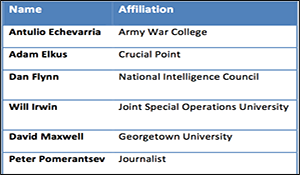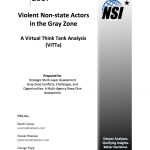Violent Non-state Actors in the Gray Zone

Violent Non-state Actors in the Gray Zone A Virtual Think Tank Analysis (ViTTa).
Author | Editor: Sarah Canna, Nicole (Peterson) Omundson, & George Popp (NSI, Inc.)
Using the Virtual Think Tank (ViTTa) expert elicitation methodology, NSI asked six leading gray zone experts whether Violent Non-state Actors (VNSAs) belong in the definition of the gray zone. However, experts were reticent to answer this question; they thought the question missed the point. The focus should not be how to define the major threats that are facing the USG, but rather how to leverage all instruments of national power to respond to them. When pushed to answer the original question, experts largely conceded that VNSAs, by themselves, do not rise to a level of significant threat in the gray zone, but are key tools used by state actors to achieve their ends. They concluded by identifying other challenges and solutions facing the USG in the gray zone.
In January 2016, General Joseph Votel (US Army) requested that the Strategic Multi-Layer Assessment (SMA) office examine how the United States Government (USG) can diagnose, identify, and assess indirect strategies, and develop response options against, associated types of gray zone challenges. More specifically, the request emphasized that if the USG is to respond effectively to the threats and opportunities presented in the increasingly gray security environment, it requires a much more detailed map of the gray zone than it currently possesses. One core question raised by General Votel was whether violent non-state actors (VNSAs), like violent extremist organizations (VEOs) and transnational criminal organizations (TCOs), fit into the definition of the gray zone.
To respond to this question, NSI applied its Virtual Think Tank (ViTTa) expert elicitation methodology to the problem set. As part of this effort, NSI interviewed six leading gray zone experts (see Table 1 and Appendix A) on whether, and under what conditions, VNSAs rise to a level of significant threat in the gray zone.
Their answers surprised us.
We Asked the Wrong Question
We initiated this effort with the objective of defining when and under what conditions VEOs and TCOs fit into the definition of the gray zone. However, experts were reticent to answer this question; they thought the question missed the point. The focus should not be how to define the major threats that are facing the USG, but rather how to leverage all instruments of national power to respond to them.
However, despite challenging the premise of the question, David Maxwell suggested that exercises like this one are useful not so much in determining the “right answer,” but rather to engage in a meaningful discussion that will help the nation better assess the challenges it faces, develop effective courses of action, and formulate plans to achieve key objectives. “Ultimately, the focus should not be on whether or not a conflict should fall into the gray zone. The US tends to try to organize everything into a clear category or create a clear label for everything,” Maxwell stated. The gray zone is ambiguous and complex, and is not suited to clear, crisp definitions.
Similarly, Adam Elkus noted that although the US would like to develop a clear dividing line between conflict and competition including who can engage in gray zone activities, other countries (primarily non-Western ones) do not think about achieving state objectives in this way. That makes it easier for them to exploit US relations without severe repercussions. Despite these reservations, we did ask the experts to respond to the original question.

Comments